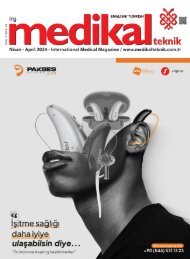Create successful ePaper yourself
Turn your PDF publications into a flip-book with our unique Google optimized e-Paper software.
Coventry University researchers<br />
bid to save lives with new device<br />
designed to prevent aquaplaning<br />
Coventry University researchers are hoping<br />
to save lives through a new device they’ve<br />
developed to prevent vehicles from<br />
aquaplaning and losing traction control<br />
due to adverse road conditions.<br />
Professor Mike Blundell and Ravi Ranjan<br />
from Coventry University’s Research<br />
Institute for Clean Growth and Future<br />
Mobility have produced the Run Dry<br />
Traction System (RDTS) following a twoyear<br />
research project.<br />
The prototype product aims to prevent<br />
aquaplaning and loss of traction in a variety<br />
of road conditions. Aquaplaning, also<br />
referred to as hydroplaning, happens when<br />
a layer of surface water builds up between<br />
a vehicle’s tyres and the road surface,<br />
leading to a complete loss of grip. This can<br />
occur with as little as 2-3mm of standing<br />
water on the road surface when vehicles<br />
are travelling at a variety of speeds and is a<br />
leading cause of road traffic accidents.<br />
The RDTS presents a novel potential<br />
solution to aquaplaning and the loss of<br />
traction by preventing water and other<br />
contaminants from reaching the tyre. The<br />
device works by firing a jet of compressed<br />
gas close to the front of the wheel,<br />
removing surface water in front of the tyre<br />
to ensure the vehicle has a dry patch of<br />
road ahead. This effectively ensures grip<br />
is not compromised by road contaminants<br />
such as water, sand and gravel.<br />
Professor Mike Blundell, Professor of<br />
Vehicle Dynamics and Impact at Coventry<br />
University, said: “Our tests demonstrate<br />
that RDTS has the potential to make a huge<br />
impact on vehicle safety in a whole host<br />
of conditions. The prospect of producing<br />
something that could even save lives on<br />
the road is extremely exciting and after<br />
some initial success with testing, we’re<br />
now eager to look into manufacturing<br />
potential and further research to take this<br />
concept to the next level.<br />
“A device like this really could be the<br />
difference between life and death if it can<br />
help vehicles to stop safely within certain<br />
distances and that’s why we’re so keen to<br />
continue developing this concept.”<br />
The RDTS has been designed to be fitted<br />
to a wide range of vehicles, including cars,<br />
buses, trucks and motorcycles and with<br />
further development, it could even have<br />
the potential to be used to improve aircraft<br />
ground operations and rail transport<br />
safety.<br />
<strong>December</strong> <strong>2021</strong> 60

















